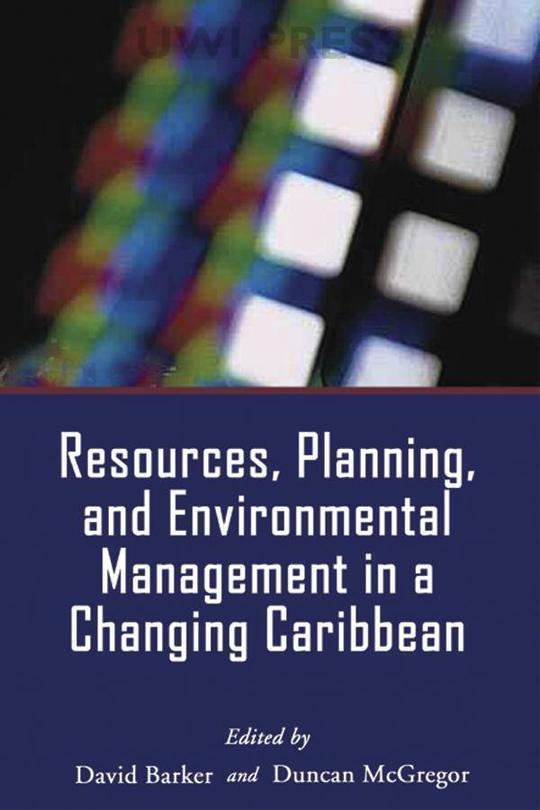
Resources, Planning and Environmental Management in a Changing Caribbean
US$ 9.99
The publisher has enabled DRM protection, which means that you need to use the BookFusion iOS, Android or Web app to read this eBook. This eBook cannot be used outside of the BookFusion platform.
Description
Contents
Reviews
Language
English
ISBN
9789766401344
Contents
List of Figures
List of Tables
Preface
Acknowledgements
Chapter 1: Environment, Resources, and Development: Some Reflections on the Caribbean Research Agenda
Reflections on the Research Agenda
References
Chapter 2: Gender and Development in the Jamaican Small-Scale Marketing System: From the 1660s to the Millennium and Beyond
Caribbean Peasantries, Development, and Gender
The African Heritage and Caribbean Gender Differentiation
A Historical Perspective on Jamaican Small-Scale Marketing
Gender Complementarity and Flexibility
Accompong and Aberdeen
The Trelawny Communities and Falmouth Market
Conclusion
Acknowledgements
Notes
References
Chapter 3: The Apparent Inflexibility of Small-Scale Farmers to Changes in Grenada’s Political-Economic Environment 1982-1992
Introduction
Survey Methodology
Social Profile of Sampled Small Farmers
Basic Characteristics of Small Holdings
Examination of Land-Use Changes by Fragment Number
Tree Crops
Vegetable Crops
Summary and Conclusion
References
Chapter 4: Yam Production and the Yam Stick Trade in Jamaica: Integrated Problems for Resource Management
Introduction
Trends and Geographical Patterns in Yam Production
The Commercialization of Yam Farming and the Evolution of the Yam Stick Problem
Organization of the Yam Stick Trade
Resource Depletion and the Viability of Yam Farming
Conclusion
References
Chapter 5: Forest Resource Use in Amerindian Villages in Guyana: Implications for Development Policy
Introduction
The Importance of Tropical Forests
Non-Timber Forest Products
Policy Failures and Tropical Forests
The Role of Environmental Valuation
Research Methodology
Participatory Research Methods Used to Investigate the Use of Non-Timber Products
Methods of Estimating Proportions and Quantities
The Accounting Framework
Determining the Value of Forest Inputs from the Net Village Product
Assessing the Value of Household Inputs and Outputs
Household Labour Inputs
The Contribution of Capital to the Household and Village Production Processes
The Distribution of Capital Stock
Estimating Household Outputs
Wildlife Use in Amerindian Villages
Fishing Methods and Species Variation
Calculating the Value of Net Village Product and the Value of Forest Use
The Importance of Broadening Values in Decision Making
The NPV Decision Rule
The Social and Cultural Importance of Non-Timber Forest Products
Attitudes to the Environment and Forest Functions
Implications for Development
Conclusion
Acknowledgements
References
Chapter 6: Rural Poverty and Development Planning: A Case Study of Moruga and Cocal in South-East Trinidad
Introduction
Patterns of Underdevelopment in Rural Trinidad
Background to the Study Area: Rural South-East Trinidad
Analysing Spatial Patterns of Rural Deprivation at the Village Level
Community Impact Assessment and Community Development Planning
Conclusion
Acknowledgements
References
Chapter 7: Vulnerability, Urbanization, and Environmental Hazard in Coastal Guyana
Introduction
Urban Flood Hazard
Socio-Economic Assets
Dwelling Tenure
Dwelling Form
Livelihood
Gender of Household Head
Household Income
Management Institutions
The Participatory Paradigm
Actor Analysis
Local Government Services: Inefficiency and Decay
Local and National Government: Partisan Management
International Donors: Perceived Change
National Funding Agencies: Enablers or Gatekeepers?
Local Political Elites: Resilience through Flexibility
Grassroots Actors: Resistance and Withdrawal
Private Sector: Slow Recovery
Multisectorial Cooperation: The Way Forward?
Conclusion
References
Chapter 8: The Responses of Residents of Nevis to Hurricane Threat: The Case of Hurricane Hugo
Introduction
Rationale for Study
Nevis: Hurricane Threat and Vulnerability
Hurricane Hugo
Methodology
Hurricane Hugo: Warning, Preparedness, and Response
Evacuation to Shelter
Hurricane Preparedness Level
The Post-Hurricane Hugo Era
Conclusions
References
Chapter 9: Matching Sustainable Tourism with Socialist Goals: Can Cuba Have It All?
Introduction
The Political, Economic, and Social Context of Tourism Development
The Growth of Tourism Since 1989
Numbers of Tourists
Tourist Origins
Hotel Capacity
The Economic Significance of Tourism Development
Growth of Tourism Income
Types of Tourism Development
Regional Distribution of Tourism Development
Constraints on Tourism Development
Leakage
Poor Infrastructure and Quality of Accommodation
Government Policy and Planning: Legal Changes and Tourism Priorities
Restructuring (Semiprivatization) of the Ministry of Tourism
Changes in Legislation to Encourage Tourism
Joint Venture Agreements
Legalized Dollar Ownership
Expanded Opportunities for Self-Employment and Small Business Licensing
Improvements to Infrastructure, Training, and Regional Cooperation
Future Targets and Goals
Expansion
Improving Quality
Market Diversification
Social Sustainability of Tourism Development
Employment and Access to Basic Goods and Services
Increase in Inequalities and Relative Deprivation
Gender Issues and the Increase in Prostitution
Increases in Crime
Environmental Sustainability of Tourism
Environmental Problems
Controls and Regulations
Conclusions
References
Chapter 10: Resort Evolution in a Narrowly Based Economy of the Pleasure Periphery: A Case Study of Montego Bay, Jamaica
Introduction
The Resort Cycle and Plantation Models
Resort Development in Montego Bay
The Resort Cycle and Plantation Models Applied to Montego Bay
The Resort Evolution Model
Number of Tourists
Accommodation
Transportation
Economic Impact
Social Impacts
Landscape Change
Conclusion
References
Chapter 11: Urbanization and Planning Issues in Montego Bay, Jamaica
Historical Background
International Tourism
Population Growth
The Housing Sector
Transportation
Environmental Degradation
The Planning Process
References
Chapter 12: Sustainable Socio-Economic Development for European Union Member States’ External Regions and Territories in the Caribbean for the Twenty-first Century
Introduction
Political Geography of Islands Connected to EU Member States
Sustainable Development Paradigm and Multidimensional Geography
Demographic and Socio-Economic Characteristics
Sustainability Criteria, Responses, and Concerns
Findings
The First Criterion: Economic Development and Infrastructure
The Second Criterion: Homogeneity and Consensus
The Third Criterion: Intergenerational Equity
The Fourth Criterion: Knowledge of Sustainable Development, Identifying Sources of Impacts
The Fifth Criterion: Social Factors, Issues, and Concerns
Actions and Strategies in EU-Connected Areas
Conclusions
References
Contributors
The book hasn't received reviews yet.











